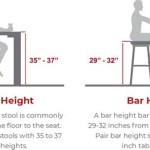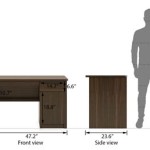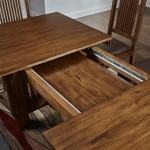Standard Study Table Height: Essential Considerations for Optimal Posture and Productivity
Selecting the right study table height is crucial for maintaining good posture, preventing discomfort, and enhancing productivity. An improperly sized table can lead to neck pain, backaches, and eye strain, affecting both physical well-being and academic performance.
In general, a standard study table should have a height that allows your forearms to rest comfortably on the table at a 90-degree angle to your upper arms. Your elbows should be bent at approximately 90 degrees when typing or writing, and your feet should touch the floor flat or use a footrest if necessary.
Here are some essential factors to consider when determining the optimal study table height:
Chair Height and Posture
The height of your chair plays a significant role in determining the ideal table height. Choose a chair that allows you to sit with your hips and knees bent at 90 degrees. Your thighs should be parallel to the floor, and the chair should provide good back support.
Height of the User
The taller you are, the higher your study table needs to be. Use the following guidelines as a reference:
- For individuals under 5'5" (165 cm): 27-29 inches (69-74 cm)
- For individuals between 5'5" (165 cm) and 5'11" (180 cm): 29-31 inches (74-79 cm)
- For individuals over 5'11" (180 cm): 31-33 inches (79-84 cm)
Activity Type
The type of activities you engage in on the study table will also influence the optimal height. For writing and reading, a lower height is generally preferred to minimize neck strain. For tasks like drawing or working on a computer, a higher height may be more comfortable.
Other Considerations
In addition to the factors mentioned above, it's also important to consider the following:
- Footrest: If your feet don't touch the floor comfortably, use a footrest to support your feet.
- Adjustable Table: An adjustable table allows you to customize the height to suit your needs.
- Personal Preferences: Ultimately, the best study table height is the one that feels the most comfortable for you.
By carefully considering these factors and following the recommended guidelines, you can choose a study table height that optimizes your posture, reduces strain, and enhances your productivity. Remember, a comfortable and well-suited study environment goes a long way in supporting your success.

This Is Why Desk Height Matters For Your Posture Arteil

Desk Height Calculator

Study Table Dimensions Free Dwg Layak Architect

Pin Page

Study Table Standard Size Free Dwg Layak Architect

Ergonomic Table Height For Laptops Desktops With Big Monitors

Kids Study Table Ben Writing Desk Gkw Retail

Kids Study Table Clearance Size

Desk Height How High Should My Be Brother
Standard Office Study Table Dimensions In Malaysia Which Desk Size Is Best For Your Workspace Frwd By Cuura Space








